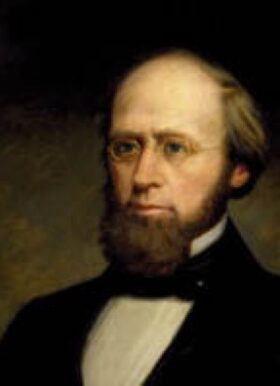
Joseph Gibson Hoyt
First Chancellor of Washington University in St. Louis, 1858-62
First Chancellor, 1858-62
1858: On October 11, the university’s board of directors approved a resolution creating the office of chancellor.
1858: In December, the Committee on Education offered the chancellorship to Joseph G. Hoyt.
1859: In May, Chancellor Hoyt proposed creating professorships of Greek, mathematics, and rhetoric and oratory; Sylvester Waterhouse was appointed Professor of Greek and William Chauvenet was named chair of mathematics and astronomy.
1859: Mary Institute, a female seminary, opened in September.
1861: Collegiate Hall, the university’s second building, was completed in September.
1862: The first five Collegiate Department (College) students graduated in June.
Joseph Gibson Hoyt, Washington University’s first chancellor, was born in Dumbarton, New Hampshire, in 1815. Until he was 16, he was only able to attend school three months a year because he was needed on the family farm.
Nevertheless, he was able to prepare himself for college and entered Yale University in 1836. There he became known for his superior scholarship, independence of character, and originality of thought and expression. He took prizes in mathematics and classics, served as editor of Yale’s famous literary magazine, and graduated sixth in a class of 100.
After graduating in 1840, he took charge of an academy in Plymouth, New Hampshire, and a year later was appointed professor of mathematics and natural philosophy at Phillips Exeter Academy in Exeter, New Hampshire, where he remained for 18 years and rose to national prominence as an educator. He was a skilled draftsman and architect, personally designing some of the buildings and furnishings in the town of Exeter.
Hoyt helped revise the New Hampshire state constitution in 1851; and in 1858, narrowly missed a congressional nomination. But that same year he accepted the appointment as chancellor and professor of Greek language and literature at Washington University. He arrived in St. Louis in 1859, he wrote, with a “controlling purpose” to develop a college.
St. Louis, the geographical centre, not only of this valley, but of the whole country, will be, to a fearful extent, responsible for the intellectual and moral character which shall be impressed upon the American people. It was in view of considerations like these, that a few far-sighted and large-hearted men…laid the foundation of Washington University.
Joseph Gibson Hoyt, Inaugural address, October 4, 1859
“Of the constituent elements of a true university,” he said in his inaugural address, “the first and most important is the college, which should give students a solid foundation in the liberal arts.” He did just that, defining the requirements and curriculum for bachelor’s degrees, which survived into the 1890s, and designating a full-time faculty for the college. His most noted hire was that of William Chauvenet, a Yale College classmate who came as the new chair of mathematics and astronomy and would later succeed him as chancellor.
The university’s Collegiate Department, the forerunner of Arts & Sciences, graduated its first class of five students near the end of his tenure in 1862, although he missed the ceremony due to illness, knowing he was dying of tuberculosis.
On October 4, Hoyt tried to resign in a final, poignant letter to William Greenleaf Eliot, who had previously refused to accept his resignation: “I need not say,” he wrote, “that it fills me with inexpressible sadness to feel constrained, at the very noon of life, to ask leave to lay down an office in which I had concentrated every worldly hope and ambition.” He died of complications from tuberculosis on November 26, 1862.
Of his service to Washington University, one biographer wrote: “The institution which he found an academy he left a university.”
William Greenleaf Eliot referred to him as “a perfect educator.”